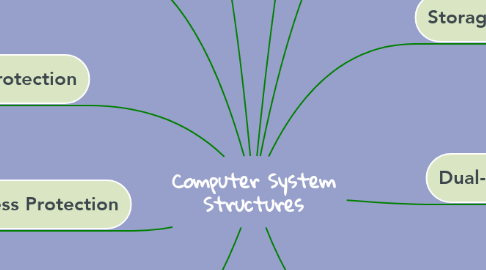Computer System Structures
by Lim Yan

1. I/O Structure
1.1. Synchronous I/O Structure
1.1.1. After I/O starts, control returns to user program only upon I/O completion.
1.2. Asynchronous I/O Structure
1.2.1. After I/O starts, control returns to userprogram without waiting for I/O completion.
2. Storage Structure
2.1. Main Storage (RAM)
2.1.1. A volatile storage device that loses its contents when power is turned off.
2.2. Secondary Storage (Hardisk)
2.2.1. Extension of main memory that provides nonvolatile storage capacity.
3. Memory Protection
3.1. The computer system must provide protection at least for the interrupt vector and the interrupt service routines.
4. Hardware Address Protection
4.1. When executing in kernel mode, the operating system has unrestricted to both monitor and user's memory.
5. CPU Protection
5.1. Timer - interrupts computer after specified period to ensure operating system maintains controls over CPU.
6. Computer-System Operation
6.1. A general-purpose computer system consists of one or more CPUs and a number of device controllers.
6.2. Device controller informs CPU that it has finished its operation by causing aninterrupt.
6.3. Each device controller has a local buffer.
7. Interrupt Handling
7.1. Interrupt vector provide the address of the interrupt serviceroutine for the interrupting device
7.2. Separate segments of code determine what action should be taken for each type of interrupt.
7.3. After the interrupt is serviced, the saved return address is loaded into the program counter.
8. Storage Hierarchy
8.1. This system organized by speed, cost and volatile.
8.2. Caching copying information into faster storage system; main memory can be viewed as a last cache for secondary storage.
9. Dual-Mode Operation
9.1. The computer system need to distinguish between the execution user mode or kernel mode.
10. I/O Protection
10.1. All I/O instruction are privileged instruction; user program cannot issue I/O instruction directly



